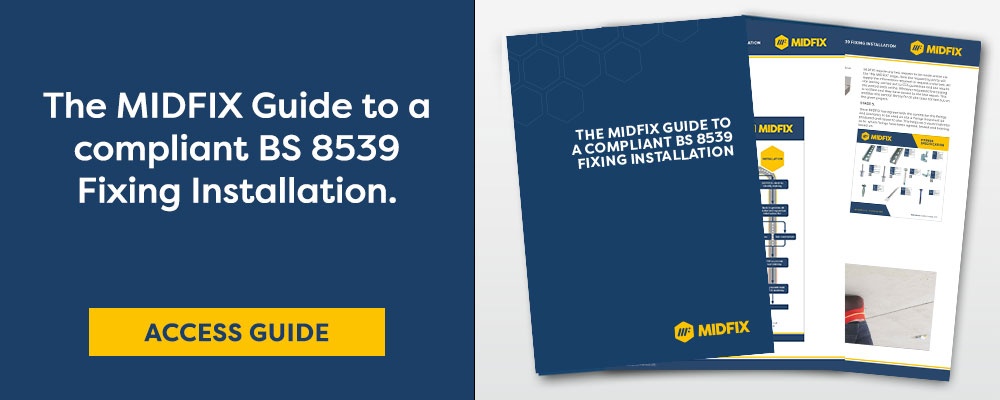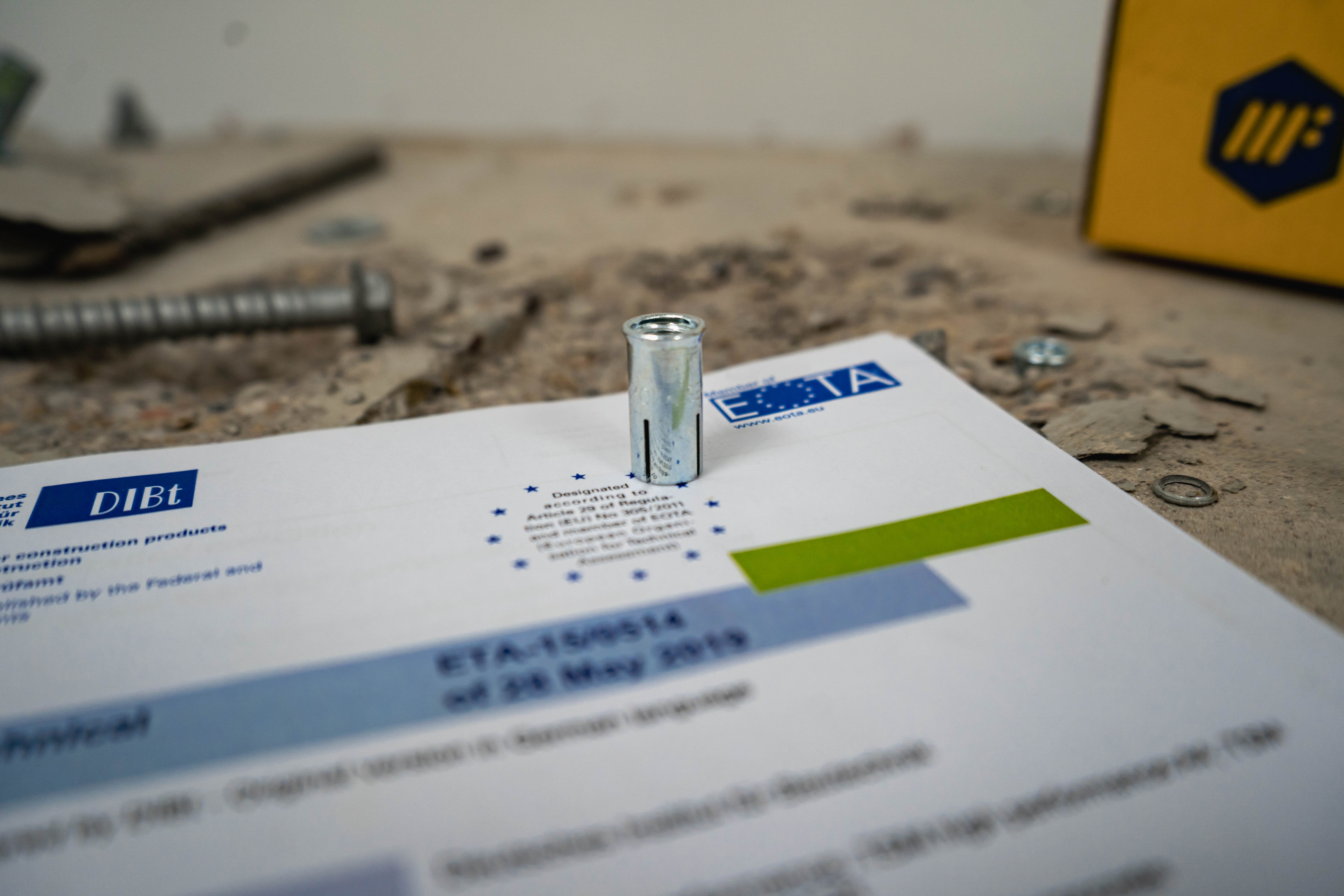Once read this blog post will provide answers to the following questions, simply jump to your preferred section.
Anchor selection - BS 8539 Guidance
How do we select an anchor in accordance with BS 8539?
What steps should be followed for a compliant anchor selection?
What type of substrate will the anchor be fixing into?
How does BS 8539 define cracked and non-cracked concrete?
What about the load surrounding an anchor?
How does the environment surrounding an anchor/fixing impact its performance?
What type of installation is appropriate for a given substrate?
Understand the working principles of the specified anchor?
What type of accreditation is required?
Selecting anchors/fixings BS8539 Guidance
Within M&E very few anchors are specified correctly. This process is usually left up to the site teams to determine what to use, or the buying teams to get the best deal. Not only does this leave you liable should anything go wrong, but you are not following the simple guidance as set out in BS 8539. Did you know that whoever selects the anchor, site teams or buyer becomes the 'specifier'?
The 'specifier' is then liable should anything go wrong. Carrying out compliant anchor/fixing selection, installation and testing doesn't have to be complex.
In our latest sound-out episode Stevan answers the key questions around anchor selection and provides an overview of BS 8539 guidance around anchor selection.
How do you select an anchor in accordance with BS8539?
Well, it is a good question because selection particularly within M&E building services tends to be a bit of a problem, what usually happens is the actual selection process is left till the end and it is the installer that has the responsibility to select the anchor and what they tend to do is usually default to an anchor they usually use to do the install with. There are six steps that need to be considered.
What steps should be followed for a compliant anchor selection?
There has got to be due diligence when it comes to anchor selection, it is important we choose the correct anchor for the specific installation. We need to look at the following factors;
- Substrate
- Loads
- Environment (internal/external)
- Type of installation (through fix or is it a flush fix)
- Working principles of the anchors
- Accreditation required
What type of substrate will the anchor be fixing onto?
What type of substrate are we fixing into, is it cracked concrete, non-cracked, is it hollow is it solid? It is imperative that we understand the type of substrate we are working with, as different types of anchors can impact the substrate uniquely. If the design strength of the substrate isn't known then an allowable load test must be carried out before the selection of anchors/fixings.
How does BS 8539 define cracked or non-cracked concrete?
Concrete is likely to be cracked from a variety of causes including permanent actions and characteristic variable actions, thermal movements, shrinkage, and the restraint of deformation. Anchors qualified for use in cracked concrete are expected to function reliably in the expected widths of cracks developed as a result of tensile stresses in concrete structures designed in accordance with BS EN 1992. In the region of an anchor, the concrete might be cracked or non-cracked.
Anchors should be chosen that are suitable for use in cracked or non-cracked concrete, as appropriate. The specifier should assume the concrete to be cracked unless an exercise has been carried out to determine whether it is cracked or non-cracked.
What about the load surrounding an anchor?
We need to look at the loads that the anchor is going to be subjected to throughout its working life.
How does the environment surrounding an anchor/fixing impact its performance?
Often overlooked and misunderstood, the environment surrounding an anchor/fixing plays an important role in the selection process.
This is because the atmosphere of an environment over time can impact an anchor/fixing resistance.
Typically the ISO 9223 classification table below is used as a guide to help select the correct anchor based on the corrosiveness of the environment.
Swimming pools need to be given special attention as the chlorinated environment affects normal grades of stainless steel impacting load-bearing elements and fixings and anchors, and are liable to fail through stress corrosion cracking.
Do you look at the ISO 9223 classification table before specifying anchors/fixings for an M&E installation?
For particular corrosive environments such as swimming pools with a chlorinated environment, special attention must be given to the finish of an anchor, this is because in certain environments the finish of an anchor can degrade making the suspension more liable to collapse.


What type of installation is appropriate for a given substrate?
We need to understand; is it through fix or a flush fix. Depending on the installation method will determine the stress on the substrate.
Understand the working principles of the specified anchor.
Did you know that all the anchors used in M&E work off just a combination of 3 basis principles?
Friction
Interlock
Bonding
By using one or a combination of the 3 basic principles we cover all anchors in our industry.
Friction: these work by basically expanding in the hole thereby creating the resistance. This expansion can be achieved by a torque applied to a through bolt or by the striking of a setting tool into a drop-in anchor. Because these anchors expand they exert a large amount of stress into the substrate which can cause issues with anchor centres and edge distances.
Interlock: these work by creating a “key” in the substrate. The best example of an interlock is the concrete screw. The helix of the screw creates the resistance required by keying into the substrate. As these anchors do not expand they cause less stress in the substrate.
Bonding: as the name suggests these anchors “bond” themselves to the substrate. Resin-type chemical anchors use this principle. In some cases, resin anchors and their studs use a combination of bonding and interlocking as their working principle. As with interlock anchors, resin bonded anchors create very little stress in the substrate.
The actual working principles of the anchor is an extremely important factor to consider when we are selecting an anchor. Certain anchors pose a large amount of stress on the substrate. For example, with a deformation-controlled anchor commonly known as a ‘drop-in anchor,’ you would not use one on brickwork as it would damage the brick. We need to look at an anchor that is kinder to the substrate. For concrete, a preferred anchor could be a concrete screw or a resin anchor.
What type of accreditation is required?
And the final bit we need to look at is the accreditation required for that install, so what do we need? ETAs, RAS approvals? It all depends on the accreditation required.
The M&E sector has a growing desire to be compliant. In order to be compliant, you must follow the guidance outlined in BS 8539. The guidance sets its stool out quite clearly on the matter of accreditation:
"Where an ETA anchor/fixing is available for the specification application, it must be sourced".
The ETA (European Technical Assessments) is a harmonised set of testing standards that an anchor/fixing must go through to attain a European Assesment document. The ETA is a document outlines the performance data of that specific anchor/fixing in conjunction with the declaration of performance, against which the design process for selecting the size of anchor is carried out.
If the 'specifier' agrees to select an ETA anchor it can greatly help, as it gives that level of assurance that the anchor can, if installed correctly, within a specific application will perform as it should.
Did you know that it costs an anchor/fixing manufacturer upwards of £1 million to maintain an ETA approval?
Overall, where an ETA anchor is available for the specific application that you are fixing into then it must be sourced.
Infact, if you know the design strength of the substrate and select an ETA anchor/fixing for that specific application and the anchor/fixing is installed and supervised by a competent individual then site testing is not required.
If you are looking for further resources such as toolbox talks then head over to the Construction Fixing Association website (CFA)
Whichever position you hold with an anchor/fixing supply chain it is imperative that you specify the anchor after going through the guidance outlined in BS 8539. In order to mitigate the risk of site failure, this is the best place to start.
Are you looking for certainty around anchor/fixings?
Feel free to email me: stevan.grkinic@midfix.co.uk
Or alternatively find the solution with our sales team: 0115 922 1585



